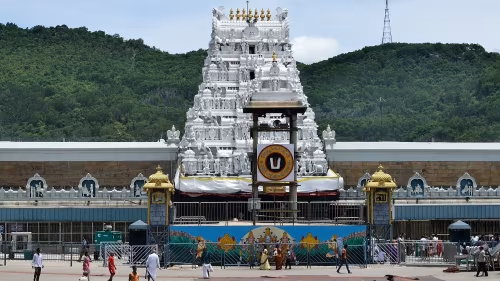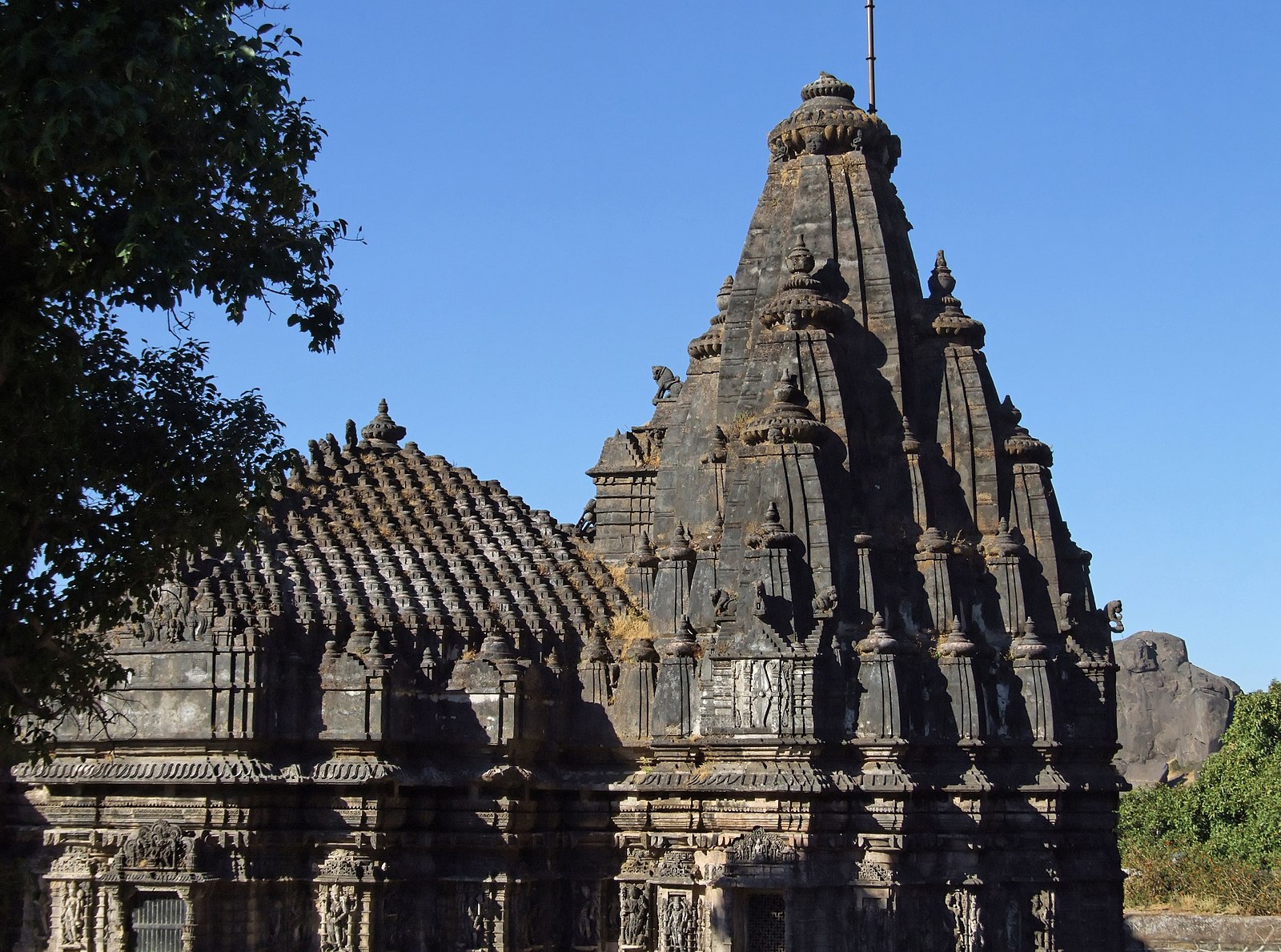India is home to some of the world’s wealthiest and most revered temples, attracting millions of devotees and massive donations every year.
These temples hold deep religious significance, cultural heritage, and immense financial wealth, often stored in the form of gold, silver, and precious jewels.

Among the top 10 richest temples in India are the world-renowned Tirupati Balaji Temple in Andhra Pradesh and the treasure-laden Padmanabhaswamy Temple in Kerala. Other temples like Shirdi Sai Baba, Vaishno Devi, and Siddhivinayak Temple are known not only for their religious importance but also for their vast donations and assets.
In this blog, we explore the wealth, history, and grandeur of these temples that continue to be pivotal religious and cultural icons of India.
1. Padmanabhaswamy Temple, Thiruvananthapuram, Kerala

Known for its immense wealth, including precious stones, gold coins, and other treasures stored in its vaults The Padmanabhaswamy Temple in Thiruvananthapuram, Kerala, is renowned not only for its spiritual significance but also for its immense wealth.
Wealth and Treasures: The temple gained global attention due to the discovery of several underground vaults (kallaras) filled with treasures, including gold coins, jewels, idols, and other valuable items. Estimates of the total value of these treasures vary widely, with some placing it among the richest temples in the world.
Historical Significance: The temple is dedicated to Lord Padmanabhaswamy (a form of Vishnu), and its origins are ancient, dating back to at least the 8th century CE. It is one of the 108 Divya Desams (holy abodes of Vishnu) mentioned in ancient texts.
Architecture: The temple is a classic example of Kerala architectural style, with intricate carvings and a towering gopuram (temple gateway). It follows the traditional Kerala temple architecture principles, including a massive wooden door covered with gold.
2. Tirumala Venkateswara Temple, Tirupati, Andhra Pradesh

The Tirumala Venkateswara Temple, located in Tirupati, Andhra Pradesh, is one of the most revered and wealthiest temples in India.
Lord Venkateswara: The temple is dedicated to Lord Venkateswara, a form of Vishnu, who is worshipped as the presiding deity.
It is believed to be one of the richest Hindu temples globally due to the vast donations it receives from devotees.
Historical Significance: Tirumala Temple is considered one of the holiest and most visited temples in India. It is part of the Tirumala Tirupati Devasthanams (TTD) trust, which manages its operations.
Hundi Collections: The temple is famous for its ‘Hundi’ collections, where devotees make offerings of money, gold, and other valuables as a token of their devotion. These offerings contribute significantly to the temple’s wealth.
Architectural : The temple complex is known for its Dravidian architecture, with its towering gopuram (temple tower) and intricate carvings depicting various episodes from Hindu mythology.
Annual Festivals: The temple hosts several annual festivals, including the Brahmotsavam, which attracts millions of pilgrims from across India and around the world.
3.Shirdi Sai Baba Temple, Shirdi, Maharashtra

The Shirdi Sai Baba Temple, located in Shirdi, Maharashtra, is a significant pilgrimage site for devotees of Sai Baba, a revered saint who lived in the late 19th and early 20th centuries.
Sai Baba of Shirdi: Sai Baba, also known as Shirdi Sai Baba, is worshipped by millions as a spiritual master and saint.
He is believed to have performed miracles and preached the importance of devotion, faith, and serving others.
Origin: The temple was built over the Samadhi (burial site) of Sai Baba after his passing in 1918. It has since become a place of worship and pilgrimage for people of various faiths.
Devotee Contributions: The temple receives substantial donations and offerings from devotees, which contribute to its maintenance and charitable activities.
Architecture: The temple complex includes the Samadhi Mandir (where Sai Baba’s tomb is located), a prayer hall, and other facilities for devotees.
Annual Festivals: Festivals such as Ram Navami, Guru Purnima, and Sai Baba’s Punyatithi (death anniversary) are celebrated with great fervor and draw large crowds of devotees.
4. Siddhivinayak Temple, Mumbai, Maharashtra

The Siddhivinayak Temple, located in Mumbai, Maharashtra, is one of the most revered and popular temples dedicated to Lord Ganesha.
Lord Ganesha: The Siddhivinayak Temple is dedicated to Lord Ganesha, who is widely worshipped as the remover of obstacles and the god of beginnings.
Origin: The temple was originally built in the 18th century by a local woman named Deubai Patil and her husband, Laxman Vithu. It has since become a prominent pilgrimage site and a cultural landmark in Mumbai.
Architecture: The temple follows traditional Hindu temple architecture, with a central dome and a golden Ganesha idol placed within a sanctum sanctorum (garbhagriha).
Devotee Visits: The Siddhivinayak Temple attracts a large number of devotees daily, especially on Tuesdays (considered auspicious for Ganesha worship) and during festivals like Ganesh Chaturthi.
Annual Festivals: Ganesh Chaturthi is celebrated with great enthusiasm at Siddhivinayak Temple, with elaborate decorations, rituals, and cultural performances.
5. Vaishno Devi Temple, Katra, Jammu and Kashmir

The Vaishno Devi Temple, located in Katra, Jammu and Kashmir, is one of the most revered and visited Hindu temples in India.
Goddess Vaishno Devi: The temple is dedicated to Goddess Vaishno Devi, also known as Mata Rani, who is believed to fulfill the wishes of her devotees.
Location and Accessibility: The temple is situated in the Trikuta Mountains, approximately 42 kilometers from Jammu city. Devotees usually undertake a trek of about 13 kilometers from the base camp at Katra to reach the temple.
Significance: Vaishno Devi Temple is one of the Shakti Peethas (sacred sites dedicated to the Goddess) in India. It holds immense spiritual significance for Hindus, who visit in large numbers throughout the year, especially during peak pilgrimage seasons.
Bhairon Temple: Near the main shrine of Vaishno Devi, there is a temple dedicated to Bhairon Nath, who is believed to be the guardian deity of the holy cave where Mata Vaishno Devi is said to have meditated.
Devotee Offerings: Devotees offer prayers, perform ‘havan’ (fire rituals), and donate to the temple trust as a token of their devotion and gratitude towards Mata Vaishno Devi.
Annual Festivals: Navaratri, particularly the period of Chaitra and Sharad Navaratri, are celebrated with great fervor at Vaishno Devi Temple. Thousands of pilgrims participate in the festivities, which include religious rituals and cultural programs.
6. Golden Temple (Harmandir Sahib), Amritsar, Punjab

The Golden Temple, also known as Harmandir Sahib, is a sacred and iconic Sikh shrine located in Amritsar, Punjab.
Sikhism and Guru Nanak: The Golden Temple is the holiest Gurdwara (place of worship) in Sikhism. It was built to house the Guru Granth Sahib, the holy scripture of Sikhism, which is treated with utmost reverence.
Architecture: The temple is known for its stunning architecture, surrounded by a serene pool of water (Amrit Sarovar) that gives Amritsar its name. The central shrine, covered in gold leaf, symbolizes the Sikh principles of humility and equality.
History: Founded in the 16th century by Guru Ram Das, the fourth Sikh Guru, the temple has undergone several renovations and expansions over the centuries, becoming the architectural marvel it is today.
Festivals and Celebrations: Major Sikh festivals such as Guru Nanak Jayanti and Vaisakhi are celebrated with great enthusiasm at the Golden Temple, drawing devotees from around the world.
7. Jagannath Temple, Puri, Odisha

The Jagannath Temple in Puri, Odisha, is one of the most revered and significant Hindu temples in India. Dedicated to Lord Jagannath, a form of Lord Vishnu, this temple is renowned for its annual Rath Yatra (chariot festival) and rich cultural heritage.
Location: The temple is located in the city of Puri, on the eastern coast of Odisha, India. Puri is considered one of the Char Dham pilgrimage sites for Hindus.
Deities: The main deities worshipped at the Jagannath Temple are Lord Jagannath (a form of Lord Vishnu), Lord Balabhadra (his elder brother), and Devi Subhadra (his younger sister).
The deities are unique as they are made of wood and are replaced every 12 or 19 years during the Nabakalebara ceremony.
Architecture: The temple architecture is a classic example of Kalinga style of architecture, characterized by its towering spires (shikharas) and intricate carvings. The temple complex is surrounded by a high fortified wall known as Meghanada Pacheri.
Rath Yatra: The Rath Yatra or Chariot Festival of Jagannath Temple is famous worldwide. It involves the deities being placed on grand chariots and pulled through the streets of Puri by devotees.
Thousands of devotees gather to witness and participate in this festival, which symbolizes the journey of the deities to their aunt’s house (Gundicha Temple) and back.
History and Significance: The Jagannath Temple has a long history dating back to ancient times and has been an important pilgrimage center for Hindus for centuries.
It is believed to have been originally built by King Anantavarman Chodaganga Deva of the Eastern Ganga dynasty in the 12th century.
Festivals and Rituals: Apart from the Rath Yatra, the temple celebrates numerous festivals throughout the year, including Chandan Yatra, Snana Yatra, and Kartik Purnima. Daily rituals and ceremonies are performed with great devotion and adherence to ancient traditions.
Administration and Visitors: It attracts millions of devotees annually from across India and around the world, making it one of the most visited religious sites in India. The temple is managed by the Shree Jagannath Temple Administration (SJTA), which oversees its operations and maintenance.
8. Siddhachal Jain Temple, Girnar, Gujarat

The Siddhachal Jain Temple is an ancient temple located on the Girnar mountain in Gujarat, India. Girnar is a prominent pilgrimage site for Jains and Hindus alike, known for its temples and sacred sites.
Location: The temple is situated on the Girnar mountain, near Junagadh in Gujarat, India. Girnar is known for its significance in Jainism and Hinduism, with numerous temples and pilgrimage routes.
Importance: Siddhachal Jain Temple holds great importance for Jains as it is believed to be one of the holiest places where several Jain Tirthankaras (spiritual teachers) attained spiritual liberation (moksha).
Architecture: The temple features ancient Jain architecture typical of the region. It includes intricate carvings and sculptures depicting Jain deities and motifs.
Pilgrimage Destination: Devotees and tourists visit Siddhachal Jain Temple as part of the larger pilgrimage to Girnar. The pilgrimage to Girnar involves climbing 5,000 steps to reach various temples and viewpoints on the mountain.
Girnar Mountain: Girnar is a significant mountain in Gujarat, known for its religious and historical significance. It is home to temples dedicated to both Jain and Hindu deities, making it a unique pilgrimage site for followers of both religions.
9. Meenakshi Amman Temple, Madurai, Tamil Nadu

The Meenakshi Amman Temple is a historic and renowned Hindu temple located in Madurai, Tamil Nadu, India.
It is dedicated to Goddess Meenakshi, an incarnation of Goddess Parvati, and her consort Lord Sundareswarar, an incarnation of Lord Shiva.
Location: The temple is situated in the heart of Madurai city in Tamil Nadu, India. Madurai itself is one of the oldest continuously inhabited cities in the world, known for its rich cultural and religious heritage.
Architecture: Meenakshi Amman Temple is renowned for its stunning Dravidian architecture. It has towering gopurams (gateway towers) adorned with thousands of colorful sculptures depicting various gods, goddesses, and mythological figures. The temple complex spans over 14 acres and is a masterpiece of ancient Indian architecture.
Main Deities: The primary deities of the temple are Goddess Meenakshi (also known as Meenakshi Amman) and Lord Sundareswarar (also known as Lord Sundareshwar or Sundareswarar).
Meenakshi is worshipped as the goddess of wisdom, arts, and fertility, while Sundareswarar is revered as the form of Shiva.
History and Legend: The temple has a history dating back to ancient times, with significant renovations and expansions undertaken during the reign of various dynasties, including the Nayak rulers of Madurai.According to legend, the temple was founded by Indra (king of the gods) himself, who worshipped Shiva here to cleanse himself of a sin.
Festivals: The temple celebrates several festivals throughout the year, including Meenakshi Thirukalyanam (the celestial wedding of Meenakshi and Sundareswarar), which attracts thousands of devotees.
Other festivals include the Meenakshi Tiruvizha, Navaratri, and Float Festival (Teppam festival), where deities are taken out in procession on a float.
Significance: Meenakshi Amman Temple is not only a major pilgrimage site for Hindus but also a significant cultural and architectural landmark in India. It attracts devotees, tourists, and scholars interested in Hindu mythology, history, and temple architecture.
10. Kashi Vishwanath Temple, Varanasi, Uttar Pradesh

The Kashi Vishwanath Temple is one of the most revered and ancient Hindu temples located in Varanasi (also known as Kashi), Uttar Pradesh, India.
It holds immense religious significance for Hindus and is dedicated to Lord Shiva, known here as Vishwanath (the ruler of the universe).
Location: The temple is situated in the heart of Varanasi, one of the oldest continuously inhabited cities in the world and a major pilgrimage site for Hindus. Varanasi is located on the banks of the holy river Ganges (Ganga).
Architecture: The original Kashi Vishwanath Temple was believed to have been constructed in ancient times, with records indicating its existence as far back as the 11th century.
The current structure dates back to the 18th century and is a fine example of Hindu temple architecture, characterized by its spire (shikhara) and intricate carvings.
Main Deity: The main deity of the temple is Lord Shiva, worshipped here in the form of Vishwanath (Lord of the Universe). The lingam (symbolic representation of Shiva) is enshrined in the sanctum sanctorum of the temple.
Significance: Kashi Vishwanath Temple is considered one of the holiest temples for Hindus, especially for followers of Shaivism (devotees of Lord Shiva). It is believed that a pilgrimage to Varanasi and a visit to this temple can grant moksha (liberation from the cycle of rebirth).
Rituals and Festivals: The temple conducts daily rituals such as Aarti (prayer ceremony) that are performed with great devotion. Special festivals such as Mahashivaratri (the Great Night of Shiva) are celebrated with elaborate rituals and fervor.
Accessibility and Visitors: The temple attracts millions of devotees and tourists annually from all parts of India and abroad. It is an important pilgrimage destination where devotees seek blessings, offer prayers, and pe
The Tirumala Venkateswara Temple, located in Tirupati, Andhra Pradesh, is one of the most revered and wealthiest temples in India.





I go to see daily a few sites and sites to read articles or reviews, except this web site presents feature based articles.
thhanks